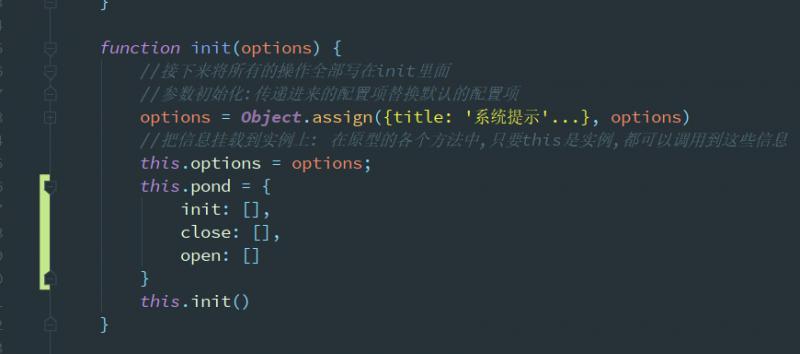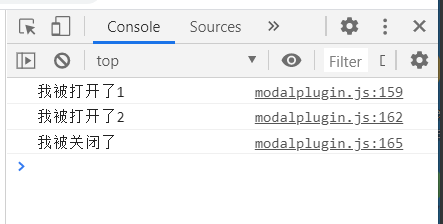基于原生JS封装的Modal对话框插件的示例代码
网络编程 发布日期:2024/11/10 浏览次数:1
正在浏览:基于原生JS封装的Modal对话框插件的示例代码
基于原生JS封装Modal对话框插件,具体内容如下所示:
原生JS封装Modal对话框插件,个人用来学习原理与思想,只有简单的基本框架的实现,可在此基础上添加更多配置项
API配置
//基本语法
let modal = ModalPlugin({
//提示的标题信息
title:'系统提示',
//内容模板 字符串 /模板字符串/DOM元素对象
template:null,
//自定义按钮信息
buttons:[{
//按钮文字
text:'确定',
click(){
//this:当前实例
}
}]
})
modal.open()//=>打开
modal.close()//=>关闭
//基于发布订阅,实现回调函数的监听
modal.on('input/open/close/dragstart/dragmove/dragend',[func])
modal.fire(...)
modal.off(...)
Modal插件核心功能的开发
导出
(function () {
function ModalPlugin() {
return
}
// 浏览器直接导入,这样的方法是暴露到全局的
window.ModalPlugin = ModalPlugin;
//如果还需要支持ES6Module/CommonJS模块导入规范,在react项目当中,vue项目当中也想用
if (typeof module !== 'undefined' && module.exports !== 'undefined') {//如果module不存在,typeof不会出错,会返回undefined
module.exports = ModalPlugin;//CommonJS规范,只有在webpack环境下才支持
}
})()
使用对象和函数创建实例
想使用创建对象的方式new ModalPlugin()创建实例或当做普通函数执行ModalPlugin(),创建实例,需要这样做
(function () {
function ModalPlugin() {
return new init()
}
//想使用创建对象的方式`new ModalPlugin()`创建实例或当做普通函数执行`ModalPlugin()`,创建实例,需要这样做
//类的原型: 公共的属性方法
ModalPlugin.prototype = {
constructor: ModalPlugin
}
function init() {}
init.prototype = ModalPlugin.prototype;
// 浏览器直接导入,这样的方法是暴露到全局的
window.ModalPlugin = ModalPlugin;
//如果还需要支持ES6Module/CommonJS模块导入规范,在react项目当中,vue项目当中也想用
if (typeof module !== 'undefined' && module.exports !== 'undefined') {//如果module不存在,typeof不会出错,会返回undefined
module.exports = ModalPlugin;//CommonJS规范,只有在webpack环境下才支持
}
})()
配置项
//封装插件的时候,需要支持很多配置项,有的配置项不传递有默认值,此时我们千万不要一个个定义形参,用对象的方式传形参,好处是可以不传,而且可以不用考虑顺序
function ModalPlugin(options) {
return new init(options)
}
//想使用创建对象的方式创建实例new ModalPlugin()或当做普通函数执行也能创建实例ModalPlugin(),需要这样做
ModalPlugin.prototype = {
constructor: ModalPlugin
}
function init(options) {
//接下来将所有的操作全部写在init里面
//参数初始化:传递进来的配置项替换默认的配置项
options = Object.assign({
title:'系统提示',
template:null,
frag:true,
buttons:[{
text:'确定',
click(){
}
}]
},options)
}
命令模式init()执行逻辑
创建DOM
//创建DOM结构
creatDom(){
//如果用creatElement插入DOM,每一次动态插入,都会导致DOM的回流,非常消耗性能,所以最外面使用createElement创建,内部使用字符串的方式拼写进去,创建好了之后放到最外层的容器当中,只引起一次回流
let frag = document.createDocumentFragment()
let dpnDialog = document.createElement('div')
dpnDialog.className = 'dpn-dialog'
dpnDialog.innerHTML = `
<div class="dpn-title">
系统温馨提示
<i class="dpn-close"></i>
</div>
<div class="dpn-content">
</div>
<div class="dpn-handle">
<button>确定</button>
<button>取消</button>
</div>`
frag.appendChild(dpnDialog)
let dpnModel = document.createElement('div')
dpnModel.className = 'dpn-model'
frag.appendChild(dpnModel)
document.body.appendChild(frag)//使用frag只需要往页面中插入一次,减少回流次数
frag = null
this.dpnDialog = dpnDialog//挂载到实例上,便于其他方法的控制隐藏,并且是私有的实例,
this.dpnModel = dpnModel
}
对参数进行处理
creatDom() {
let {title, template, buttons} = this.options
//如果用creatElement插入DOM,每一次动态插入,都会导致DOM的回流,非常消耗性能,所以最外面使用createElement创建,内部使用字符串的方式拼写进去,创建好了之后放到最外层的容器当中,只引起一次回流
let frag = document.createDocumentFragment()
let dpnDialog = document.createElement('div')
dpnDialog.className = 'dpn-dialog'
dpnDialog.innerHTML = `
<div class="dpn-title">
${title}
<i class="dpn-close">X</i>
</div>
<div class="dpn-content">
${template && typeof template === 'object' && template.nodeType === 1
"dpn-handle">
${buttons.map((item, index) => {
return `<button index="${index}">${item.text}</button>`
}).join('')}
</div>`
: ''
}
`
frag.appendChild(dpnDialog)
let dpnModel = document.createElement('div')
dpnModel.className = 'dpn-model'
frag.appendChild(dpnModel)
document.body.appendChild(frag)//使用frag只需要往页面中插入一次,减少回流次数
frag = null
this.dpnDialog = dpnDialog//挂载到实例上,便于其他方法的控制隐藏,并且是私有的实例,
this.dpnModel = dpnModel
},
控制隐藏与显示
//控制他显示
open() {
this.dpnDialog.style.display = 'block'
this.dpnModel.style.display = 'block'
},
//控制隐藏
close() {
this.dpnDialog.style.display = 'none'
this.dpnModel.style.display = 'none'
}
基于事件委托处理点击事件
init() {
this.creatDom()
//基于事件委托,实现点击事件的处理
this.dpnDialog.addEventListener('click', (ev)=>{
let target = ev.target,
{tagName,className}= target
console.log([target])
//点击的关闭按钮
if(tagName==='I'&&className.includes('dpn-close')){
this.close()
return
}
//点击的是底部按钮
if(tagName==='BUTTON' && target.parentNode.className.includes('dpn-handle')){
let index = target.getAttribute('index')
//让传过来的函数执行,并且函数中的this还必须是当前实例
let func = this.options.buttons[index]['click']
if(typeof func==='function'){
func.call(this)
}
return
}
})
},
基于发布订阅实现回调函数的监听(生命周期)
完整代码
//modalplugin.js
(function () {
//封装插件的时候,需要支持很多配置项,有的配置项不传递有默认值,此时我们千万不要一个个定义形参,用对象的方式传形参,好处是可以不穿,而且可以不用考虑顺序
function ModalPlugin(options) {
return new init(options)
}
//想使用创建对象的方式创建实例new ModalPlugin()或当做普通函数执行也能创建实例ModalPlugin(),需要这样做
ModalPlugin.prototype = {
constructor: ModalPlugin,
//相当于大脑,可以控制先干什么在干什么(命令模式)
init() {
//创建DOM结构
this.creatDom()
//基于事件委托,实现点击事件的处理
this.dpnDialog.addEventListener('click', (ev) => {
let target = ev.target,
{tagName, className} = target
//点击的关闭按钮
if (tagName === 'I' && className.includes('dpn-close')) {
this.close()
return
}
//点击的是底部按钮
if (tagName === 'BUTTON' && target.parentNode.className.includes('dpn-handle')) {
let index = target.getAttribute('index')
//让传过来的函数执行,并且函数中的this还必须是当前实例
let func = this.options.buttons[index]['click']
if (typeof func === 'function') {
func.call(this)
}
return
}
})
this.fire('init')//通知init方法执行成功
},
//创建DOM结构
creatDom() {
let {title, template, buttons} = this.options
//如果用creatElement插入DOM,每一次动态插入,都会导致DOM的回流,非常消耗性能,所以最外面使用createElement创建,内部使用字符串的方式拼写进去,创建好了之后放到最外层的容器当中,只引起一次回流
let frag = document.createDocumentFragment()
let dpnDialog = document.createElement('div')
dpnDialog.className = 'dpn-dialog'
dpnDialog.innerHTML = `
<div class="dpn-title">
${title}
<i class="dpn-close">X</i>
</div>
<div class="dpn-content">
${template && typeof template === 'object' && template.nodeType === 1
"dpn-handle">
${buttons.map((item, index) => {
return `<button index="${index}">${item.text}</button>`
}).join('')}
</div>`
: ''
}
`
frag.appendChild(dpnDialog)
let dpnModel = document.createElement('div')
dpnModel.className = 'dpn-model'
frag.appendChild(dpnModel)
document.body.appendChild(frag)//使用frag只需要往页面中插入一次,减少回流次数
frag = null
this.dpnDialog = dpnDialog//挂载到实例上,便于其他方法的控制隐藏,并且是私有的实例,
this.dpnModel = dpnModel
},
//控制他显示
open() {
this.dpnDialog.style.display = 'block'
this.dpnModel.style.display = 'block'
this.fire('open')//通知open方法执行成功
},
//控制隐藏
close() {
this.dpnDialog.style.display = 'none'
this.dpnModel.style.display = 'none'
this.fire('close')//通知close方法执行成功
},
//on向事件池中订阅方法
on(type, func) {
let arr = this.pond[type]
if(arr.includes(func)) return
arr.push(func)
},
//通知事件池中的方法执行
fire(type) {
let arr = this.pond[type]
arr.forEach(item => {
if(typeof item ==='function'){
item.call(this)
}
})
}
}
function init(options) {
//接下来将所有的操作全部写在init里面
//参数初始化:传递进来的配置项替换默认的配置项
options = Object.assign({
title: '系统提示',
template: null,
frag: true,
buttons: [{}]
}, options)
//把信息挂载到实例上: 在原型的各个方法中,只要this是实例,都可以调用到这些信息
this.options = options;
this.pond = {
init: [],
close: [],
open: []
}
this.init()
}
init.prototype = ModalPlugin.prototype;
// 浏览器直接导入,这样的方法是暴露到全局的
window.ModalPlugin = ModalPlugin;
//如果还需要支持ES6Module/CommonJS模块导入规范,在react项目当中,vue项目当中也想用
if (typeof module !== 'undefined' && module.exports !== 'undefined') {//如果module不存在,typeof不会出错,会返回undefined
module.exports = ModalPlugin;//CommonJS规范,只有在webpack环境下才支持
}
})()
使用
使用时需要引入modalpugin.js和modalpugin.css
使用示例1:
//使用:
const modal1 = ModalPlugin({
//提示的标题信息
title: '系统提示',
//内容模板 字符串 /模板字符串/DOM元素对象
template: null,
//自定义按钮信息
buttons: [{
//按钮文字
text: '确定',
click() {
//this:当前实例
this.close()
}
}, {
//按钮文字
text: '取消',
click() {
//this:当前实例
this.close()
},
}]
})
modal1.on('open',()=>{
console.log('我被打开了1')
})
modal1.on('open',()=>{
console.log('我被打开了2')
})
modal1.on('close',()=>{
console.log('我被关闭了')
})
modal1.open()
使用示例2:
github
完整代码github
在去年的5月23日,借助Intel Bridge Technology以及Intel Celadon两项技术的驱动,Intel为PC用户带来了Android On Windows(AOW)平台,并携手国内软件公司腾讯共同推出了腾讯应用宝电脑版,将Windows与安卓两大生态进行了融合,PC的使用体验随即被带入到了一个全新的阶段。








